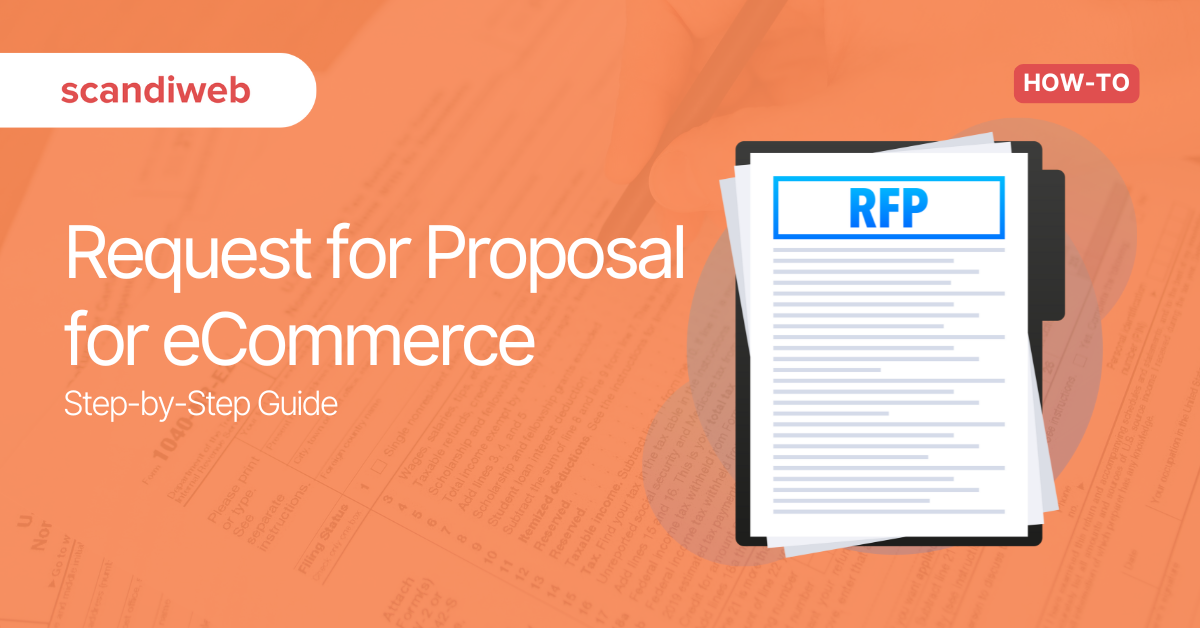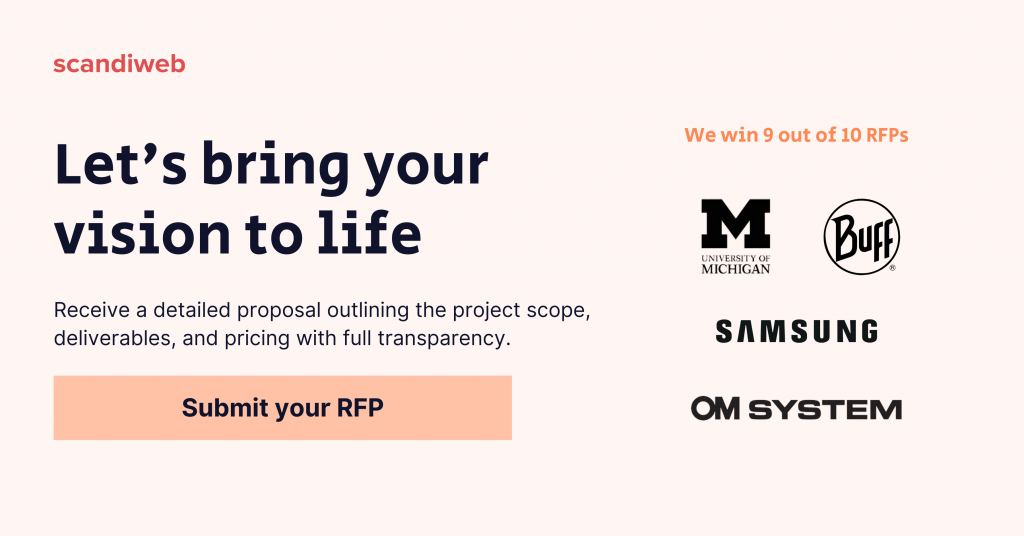If you’re planning a replatforming, redesign, or a new digital experience or are embarking on any eCommerce project without the right partner, you risk running into costly issues and delays. One of the best tools for ensuring your project runs smoothly is an eCommerce Request for Proposal (RFP), outlining your business requirements, project scope, and expectations. It becomes a roadmap for your potential technological and strategic partners to provide the most suitable solutions. Let’s explore how to craft an effective RFP for your eCommerce project.
What is an eCommerce RFP?
An eCommerce RFP (Request for Proposal) is a formal document outlining your business’s objectives, project scope, technical requirements, company background, and specific eCommerce platform or solution needs. Its primary purpose is to find an agency to undertake your project.
RFP serves as a detailed guide that allows agencies to understand your expectations and propose solutions that best align with your goals.
Why you need an eCommerce RFP
Writing an RFP helps you:
- Clarify business and project goals and ensure they are communicated
- Streamline agency selection, as it allows potential agencies to propose solutions that align with your specific needs
- Provide a uniform way for agencies to respond, making it easier to compare proposals
- Reduce the risk of project misalignment and delays
- Make sure agencies and stakeholders are on the same page from the get-go.
Key sections of an eCommerce RFP
Introduction and company overview
Start by providing a brief background of your company—industry, mission, business model, and any relevant history. Highlight key milestones, unique selling points, and your position in the market to help agencies understand your brand and tailor their responses to your business context.
Project overview and goals
Provide a summary of your eCommerce project, including its purpose and objectives. Clearly outline the strategic, operational, and technical goals, like increasing sales, improving customer experience, streamlining backend operations, or integrating new technologies.
Scope of work
Specify the full scope of the project with details like the deliverables you expect, the timeline, and any key phases or milestones. You have to be clear about what you want to achieve with this project, giving agencies a clear understanding of its size and complexity.
Technical and functional requirements
Outline the technical and functional requirements and specify any necessary platform features, integrations with other systems, and security requirements, as well as details like payment gateways, CRM, ERP, or third-party software.
Next, we have outlined all the steps to take, from defining your project to writing all RFP sections (with a free template for you to use) and selecting your agency partner.
Step-by-step guide to writing an RFP
Step 1: Define goals and gather stakeholder input
Begin by establishing your primary goals for the eCommerce project. Objectives you come up with at this step will shape your RFP, helping you identify the best-fit agencies. Consider breaking down your goals into these categories:
- Strategic goals—high-level ambitions such as expanding to new markets, increasing sales, or improving customer retention
- Technical goals—essential technical requirements, such as security standards and system integrations
- Operational goals—workflow improvements, like streamlining the sales process or optimizing order fulfillment.
Engage stakeholders across departments (e.g., IT, sales, and marketing) to gather insights and align on priorities, ensuring all perspectives are accounted for and creating a solid foundation for your project.
Step 2: Determine a timeline
Depending on project complexity, the RFP process can span several months, from initial drafting to agency selection, with additional months for implementation. Setting a realistic timeline will help keep the process on track and manage expectations.
Be sure to outline your desired implementation timeline in the RFP and ask companies about their standard turnaround times to align both parties on the expected project duration. Complex projects can take up to a year, so plan accordingly.
At scandiweb, we always strive for smooth project implementation. For example, it took only 95 days from project sign-off to launch, and the go-live procedure was completed in less than 15 minutes for three new PUMA Magento stores launched by scandiweb. Read more about this project here.
Step 3: RFP writing
Contact information and company background
Begin your RFP with a designated point of contact for questions and proposal submissions.
Next, provide a brief overview of your company’s history, mission, and core values. Sharing this context helps vendors understand your brand and align their proposals with your vision. The more comprehensive the background, the easier it is for potential partners to tailor their recommendations to your project’s immediate needs and long-term goals.
Project scope and goals
Start by summarizing the purpose of the project. Provide an overview that outlines both the “why” and “what” of your eCommerce project. Is this a new implementation, a replatforming, or part of a strategic pivot?
Include a prioritized list of at least four to five key strategic, operational, and technical goals. Highlight the must-have features and required integrations to support your business needs and any expectations for future development and scalability.
Also, include a high-level project timeline to give vendors an initial sense of timing and deadlines. You will cover these points in more detail later in the RFP.
Current challenges
Describe the challenges or pain points that make a new eCommerce platform or update essential for your business. This section can cover issues like poor customer experience, limitations in delivering an omnichannel approach, lost sales from downtime, or lack of support for your current solution. Additionally, highlight any specific platform limitations, such as high shopping cart abandonment rates or scalability concerns.
Technical and functional requirements
This section outlines the critical features and technical specifications your eCommerce platform must support. Include these details:
- Platform preference and specification if you prefer a cloud-based or on-premise solution
- Architecture needs to indicate headless architecture or another backend setup
- Data migration from an existing platform
- A detailed list of essential features and functionalities, like product catalog management, order processing, diverse payment methods, inventory management, discounts, etc.
- Performance benchmarks and scalability requirements, expected transaction processing speeds, load capacity, and the ability to handle large volumes of traffic (page load times, uptime, and responsiveness during seasonal peaks or business expansions)
- Security requirements and protocols necessary to protect customer and employee data.
Integrations
Specify the integrations your eCommerce platform must support to ensure seamless functionality with existing systems. Provide a list of tools you currently use and detail any necessary connections with CRM (customer relationship management), ERP (enterprise resource planning) software, and preferred payment gateways for handling transactions. Also, include any required integrations with other sales channels or distribution networks.
Required agency expertise
Outline the qualifications, experience, and credentials you expect from potential partners. Specify your need for a strong track record in delivering eCommerce solutions, and request relevant examples, client feedback, or case studies demonstrating their success with similar projects. Additionally, inquire about their experience working with businesses in your industry.
Establish clear criteria for evaluating proposals, including capabilities, team expertise, pricing, and data security practices. Provide this information upfront to ensure transparency!
Timeline and deliverables
Provide a detailed timeline for the project, including each phase and key milestones with specific target dates for implementation, along with expected deliverables, such as the eCommerce platform itself, ongoing support, training, and maintenance requirements.
Include a preferred timeline to help agencies assess their capacity to complete the project within your time frame.
Your budget
In this section, you should clearly state your project budget and any constraints that might impact proposals. Specify any preferred pricing model, such as subscription-based pricing or per-transaction fees, and ask agencies to break down pricing—whether per role, hourly rate, or as a fixed time estimate. It’s also helpful to request clarity on any additional costs for ongoing support or future integrations. If an agency can’t meet your budget, ask them to provide reasoning and suggest a revised budget where possible.
Agency evaluation metrics
Define the criteria and process for evaluating and selecting your strategic partner. You should consider how well a vendor meets technical and functional requirements, cost-effectiveness, track record, alignment with your project goals, and proposed timeline.
Provide detailed response guidelines covering length, required details, document format, and whether a hard copy is necessary, along with a digital version.
Finalize this section by stating the deadline for response submissions and specifying a decision date so agencies know when to anticipate a response.
Step 4: RFP distribution
Once your RFP is complete, distribute it to begin gathering proposals. Here are different ways to reach eCommerce agencies:
- Direct contact—if you already have preferred agencies, send your RFP directly to them
- Email lists—if you have industry contacts or a company newsletter, you can send out an announcement about your RFP
- Company website—publishing your RFP on a dedicated landing page on your company’s website can attract agencies that are specifically interested in working with your brand
- RFP distribution services—some online platforms and RFP management software can assist in distributing your RFP to a network of pre-qualified agencies based on industry, project type, and region
- Professional networking—utilizing LinkedIn or professional networking groups specific to eCommerce or your industry.
Does scandiweb accept eCommerce RFPs?
Absolutely—scandiweb welcomes eCommerce RFP submissions and is ready to bring your project vision to life. To submit your RFP, simply email your project requirements, timeline, and budget to [email protected] or submit it through our RFP submission form. We also offer NDA agreements to ensure the confidentiality of your project details.
Our team will thoroughly review your RFP, analyze your project’s unique needs and objectives, and craft a tailored approach aligned with your goals. Upon acceptance, you will receive a detailed proposal that outlines the project scope, deliverables, and transparent pricing, ensuring we’re fully aligned on the path forward.
Recently won RFPs have connected scandiweb with exciting projects for notable clients. OM Digital Solutions, a leader in opto-digital products, has chosen scandiweb to support ongoing work and a new redesign project. We will also help them address fragmented touchpoints, improve user experience, and maximize regional digital sales conversions.
scandiweb is also proud to support one of the eCommerce projects for the University of Michigan, a leading institution with a rich legacy and an alumni network. We’re excited to assist them with their eCommerce needs and explore future opportunities to expand our collaboration.
If you’re ready to kickstart your eCommerce project, scandiweb will gladly respond to your RFP—and if you need help drafting it or have any questions, our team is here to assist. Send your project details or inquiries to [email protected], and let’s start your brand’s success story!



Share on: